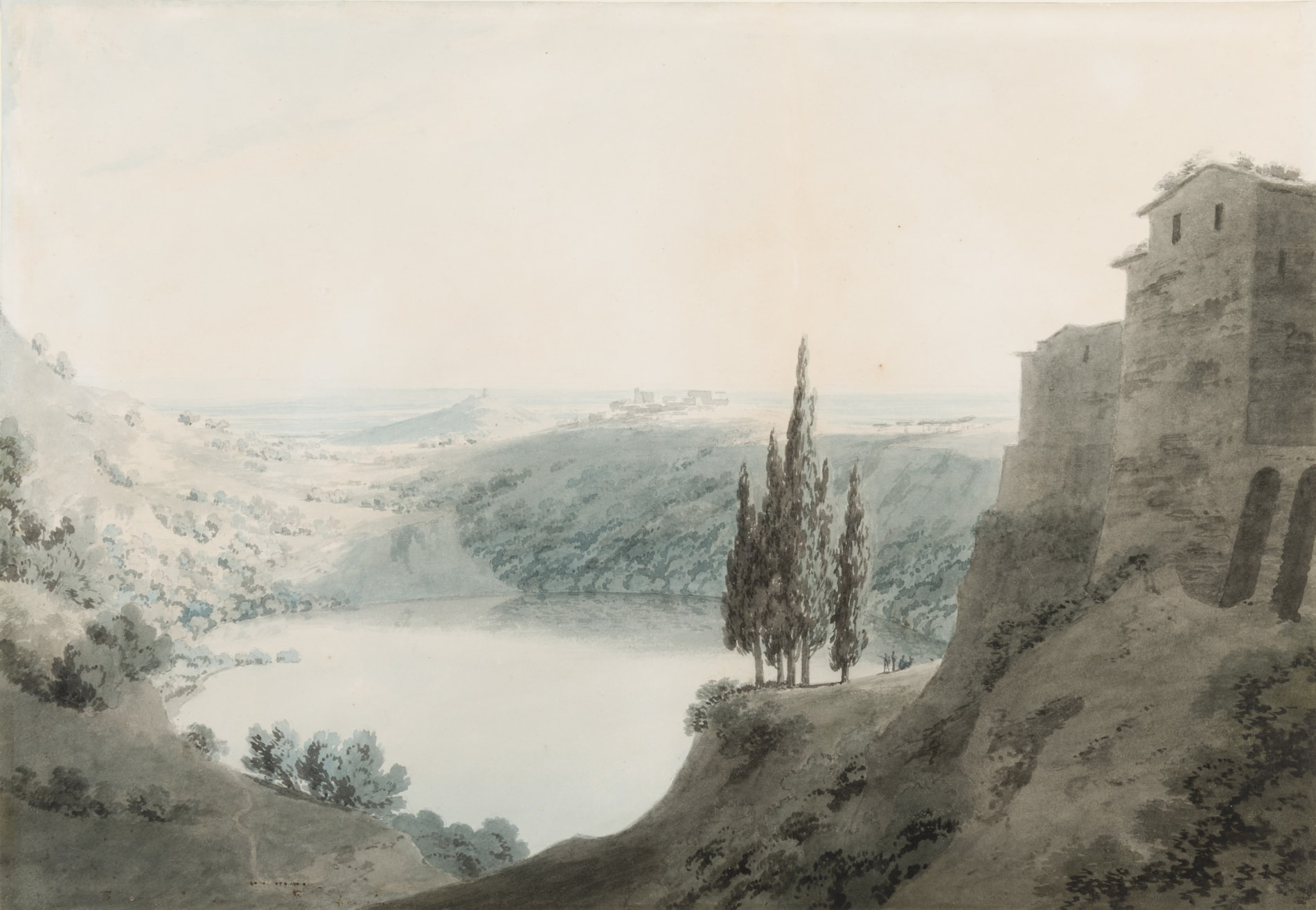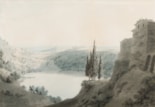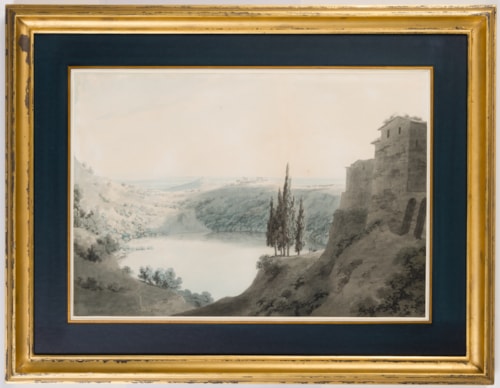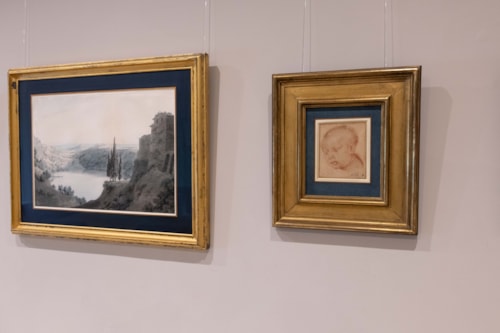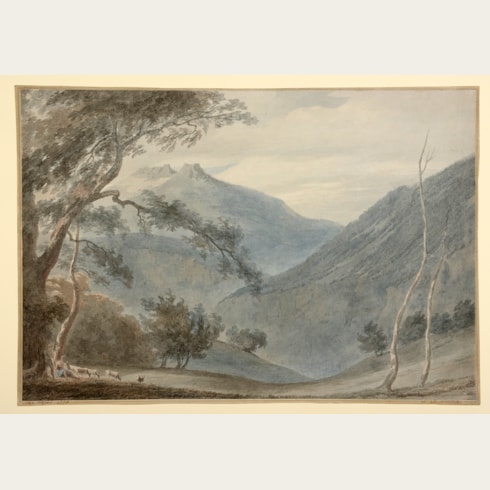John Robert COZENS
(London 1752 - London 1797)
Lake Nemi looking towards Genzano
Watercolour over a pencil underdrawing.
363 x 525 mm. (14 1/4 x 20 5/8 in.)
363 x 525 mm. (14 1/4 x 20 5/8 in.)
Drawn in subtle washes of pale blue, green and gray, the present sheet is a fine example of John Robert Cozens’s watercolour technique, and depicts one of the artist’s favourite subjects. Lake Nemi is a small, almost circular lake set in the crater of an extinct volcanic situated about thirty kilometres southeast of Rome. (In Roman times it was also known in Latin as ‘Speculum Dianae’, or ‘The Mirror of Diana’, since the lake and its surrounding forest were sacred to the goddess Diana.) The small town of Nemi overlooks the northeastern side of the lake, while the town of Genzano (today called Genzano di Roma) is situated on the opposite side. Cozens depicted Lake Nemi, from different viewpoints, in a number of watercolours and drawings., as well as in several sketchbook pages.
Cozens often repeated his compositions, and this particular view of Lake Nemi seems to have been among his most popular works, to judge by the several autograph versions of it that are known, executed between 1778 and 1790. These include examples in the Fitzwilliam Museum in Cambridge, the Victoria and Albert Museum in London, the Whitworth Art Gallery in Manchester, the Rhode Island School of Design in Providence, Rhode Island, and the Art Gallery of Ontario in Toronto, as well as a number of private collections. As one scholar has noted of this composition, ‘Lake Nemi was redolent with classical associations and Cozens has successfully captured the aura of the site by placing the foreground in deep shadow, making the lake dead calm, like a mirror, while the eye is led from the crater’s rim to the vastness of the coastal plain beyond, and on to the distant islands.’
Kim Sloan has further noted of this particular composition of Lake Nemi by Cozens that ‘The popularity of this watercolour may have been due to its extremely classical composition, as well as its well-known subject. Lake Nemi (‘Speculum Dianae’, the Mirror of Diana), was the centre of the cult of Diana, whose temple was situated out of sight of this view, below the town and castle of Nemi, to which belong the arcades acting as a repoussoir on the right.’
In his Gentleman’s Guide in his Tour Through Italy, published around the same time that Cozens drew this watercolour, the late 18th century English botanist and traveller Thomas Martyn wrote that ‘The other beautiful lake of Nemi is also a crater of an extinct volcano. It was anciently called speculum Dianae and lacus Aricinus. Riccia is near this lake; as is also Genzano, called so corruptly from Cynthianum, and placed opposite to the town of Nemi. From the garden of the Capuchins, just above the lake, is the most delicious prospect imaginable. All the eminences about both these lakes are shaded with forest trees: the water and wood set off each other, and combine to form a landscape, which is at the same time delightful, and unusual in Italy.’
Cozens often repeated his compositions, and this particular view of Lake Nemi seems to have been among his most popular works, to judge by the several autograph versions of it that are known, executed between 1778 and 1790. These include examples in the Fitzwilliam Museum in Cambridge, the Victoria and Albert Museum in London, the Whitworth Art Gallery in Manchester, the Rhode Island School of Design in Providence, Rhode Island, and the Art Gallery of Ontario in Toronto, as well as a number of private collections. As one scholar has noted of this composition, ‘Lake Nemi was redolent with classical associations and Cozens has successfully captured the aura of the site by placing the foreground in deep shadow, making the lake dead calm, like a mirror, while the eye is led from the crater’s rim to the vastness of the coastal plain beyond, and on to the distant islands.’
Kim Sloan has further noted of this particular composition of Lake Nemi by Cozens that ‘The popularity of this watercolour may have been due to its extremely classical composition, as well as its well-known subject. Lake Nemi (‘Speculum Dianae’, the Mirror of Diana), was the centre of the cult of Diana, whose temple was situated out of sight of this view, below the town and castle of Nemi, to which belong the arcades acting as a repoussoir on the right.’
In his Gentleman’s Guide in his Tour Through Italy, published around the same time that Cozens drew this watercolour, the late 18th century English botanist and traveller Thomas Martyn wrote that ‘The other beautiful lake of Nemi is also a crater of an extinct volcano. It was anciently called speculum Dianae and lacus Aricinus. Riccia is near this lake; as is also Genzano, called so corruptly from Cynthianum, and placed opposite to the town of Nemi. From the garden of the Capuchins, just above the lake, is the most delicious prospect imaginable. All the eminences about both these lakes are shaded with forest trees: the water and wood set off each other, and combine to form a landscape, which is at the same time delightful, and unusual in Italy.’
‘All poetry…the greatest genius that ever touched landscape.’ The painter John Constable’s opinion of the work of John Robert Cozens reflects something of the esteem in which his watercolour landscapes were held long after his death. The only son and pupil of the drawing master Alexander Cozens, John Robert Cozens first exhibited at the Society of Artists in 1767 and continued to do so until 1771. In 1776 he made his first trip to Italy, thirty years after that of his father. In the company of the scholar, antiquarian and collector Richard Payne Knight, the younger Cozens travelled through Switzerland and the Alps before arriving in Rome in November 1776. He was to stay in Rome for almost two and half years, until April 1779, making sketching tours of the Roman countryside, often working alongside the Welsh artist Thomas Jones. It was also in Rome that Cozens worked up his Swiss alpine sketches into larger, atmospheric watercolours for Payne Knight and other patrons.
A second trip to Italy in 1782-1783, in the retinue of the wealthy collector William Beckford, resulted in Cozens spending several months in Naples, and then in Rome, and producing a series of almost a hundred finished watercolours of Italian views for Beckford that can be counted among his finest works. Cozens’ health deteriorated in the 1790s, however, and in 1794 he suffered a severe nervous breakdown. He was admitted to the Bethlem Royal Hospital asylum and there placed under the care of the physician and collector Dr. Thomas Monro, who had many of Cozens’s Continental sketches copied by younger artists such as J. M. W. Turner and Thomas Girtin. Cozens died in London in December 1797, at the age of just forty-five.
Cozens seems to have worked exclusively as a draughtsman, and almost no oil paintings by his hand are known. (A now-lost painting of Hannibal Crossing the Alps was exhibited at the Royal Academy in 1776; the only occasion that he showed his work there.) Although his reputation was based solely on his work as a watercolourist, none of Cozens’s works were engraved, with the result that there was no wider dissemination of his compositions through the medium of reproductive prints. Nevertheless, his watercolours were to be enormously influential among the succeeding generation of English landscape draughtsmen.
For most of his relatively brief career of some twenty years, Cozens worked in a limited palette of light blues, greens and greys, avoiding vivid effects and contrasts in favour of a tonal, atmospheric approach to landscape. As Timothy Wilcox has remarked, ‘the near monochrome watercolours of Cozens…opened up unforeseen possibilities - not only to Turner, but to an entire generation of painters exposed to his work at the London house of Dr Thomas Monro. Monro employed Turner, Girtin and other young artists, including John Varley and John Sell Cotman, to make copies of compositions by Cozens. It was less the subjects themselves, scenes in the Roman Campagna or the Bay of Naples, than the subtlety of Cozens’s wash technique which made the greatest impression; through the extreme refinement of his graduated colour, Cozens evoked the fabled clarity of the Italian atmosphere, and an almost infinite spatial recession.’
A second trip to Italy in 1782-1783, in the retinue of the wealthy collector William Beckford, resulted in Cozens spending several months in Naples, and then in Rome, and producing a series of almost a hundred finished watercolours of Italian views for Beckford that can be counted among his finest works. Cozens’ health deteriorated in the 1790s, however, and in 1794 he suffered a severe nervous breakdown. He was admitted to the Bethlem Royal Hospital asylum and there placed under the care of the physician and collector Dr. Thomas Monro, who had many of Cozens’s Continental sketches copied by younger artists such as J. M. W. Turner and Thomas Girtin. Cozens died in London in December 1797, at the age of just forty-five.
Cozens seems to have worked exclusively as a draughtsman, and almost no oil paintings by his hand are known. (A now-lost painting of Hannibal Crossing the Alps was exhibited at the Royal Academy in 1776; the only occasion that he showed his work there.) Although his reputation was based solely on his work as a watercolourist, none of Cozens’s works were engraved, with the result that there was no wider dissemination of his compositions through the medium of reproductive prints. Nevertheless, his watercolours were to be enormously influential among the succeeding generation of English landscape draughtsmen.
For most of his relatively brief career of some twenty years, Cozens worked in a limited palette of light blues, greens and greys, avoiding vivid effects and contrasts in favour of a tonal, atmospheric approach to landscape. As Timothy Wilcox has remarked, ‘the near monochrome watercolours of Cozens…opened up unforeseen possibilities - not only to Turner, but to an entire generation of painters exposed to his work at the London house of Dr Thomas Monro. Monro employed Turner, Girtin and other young artists, including John Varley and John Sell Cotman, to make copies of compositions by Cozens. It was less the subjects themselves, scenes in the Roman Campagna or the Bay of Naples, than the subtlety of Cozens’s wash technique which made the greatest impression; through the extreme refinement of his graduated colour, Cozens evoked the fabled clarity of the Italian atmosphere, and an almost infinite spatial recession.’
Provenance
Anonymous sale, London, Sotheby’s, 26 November 1998, lot 63
Jacqui (Jacob) Eli Safra, Geneva.
Jacqui (Jacob) Eli Safra, Geneva.

